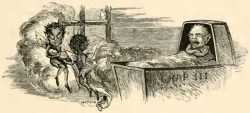changeling
A usually ugly and stupid child that is supposed to have been left behind by fairies in exchange for a more attractive one. These children are sometimes old fairies or the bastard children of nixies and humans whom they have dragged under the sea.
It was thought that fairies could only change their weakly and more starveling elves for the more robust offspring of men before baptism. In the Highlands, children used to be watched until the christening was over, lest they should be stolen or changed by the fairies. Should the elves succeed in their attempts, they left behind instead of the mother, and bearing her semblance, a stock of wood (stoc maide) and in place of the infant an old mannikin of their own race. Such an aged elf is called sìthbheire. The child grew up a peevish misshapen brat, ever crying and complaining. A changeling can be detected by its huge appetite and the large quantity of water it drink (a bathtub before morning, if left beside it), its large teeth, its fondness for music and its powers of dancing, its unnatural precocity, or from some unguarded remark as to its own age. They can also be detected by placing empty egg shells round the hearth. The changeling, when he thinks himself unobserved, gets up from the bed and examines them. Finding them empty, he is heard to remark, as he peers into each, this is but a wind-bag (chan eil a' so ach balg fàs); I am so many hundred years old, and I never saw the like of this.
A changeling could be driven away by running at him with a red-hot plowshare; by getting between him and the bed and threathening him with a drawn sword; by leaving him out on the hillside; by putting him sitting on a gridiron, or in a creel, above a fire; by sprinkling him well out of the maistir (urine) tub; or by dropping him into the river.
A story concerning a changeling is related by Pennant in his A tour in Scotland: A poor cottager, who lived near the Fairy Oak, had a child who grew uncommonly peevish; the parents attributed this to the fairies, and imagined that it was a changeling. They took the child, put it in a cradle, and left it all night beneath the tree, in hopes that the tylwydd têg, or fairy family, or the fairy folk, would restore their own before morning. When morning came they found the child perfectly quiet, so went away with it, quite confirmed in their belief.
It appears from Strype's Annals of the Reformation, under 1567, that midwives took an oath, inter alia, not to suffer any other body's child to be set, brought, or laid before any woman delivered of child in the place of her natural child, so far forth as I can know and understand. Also, I will not use any kind of sorcery or incantation in the time of the travail of any woman.
A method for discovering if whether a child belongs to the fairies is described in the book A Pleasant Treatise of Witches (1673).
❧
References
Sources
- Bonnerjea, Biren. (1920). A Dictionary of Superstitions and Mythology. Thomson Gale.
- Campbell, J.G. (1900). Superstitions of the Highlands and Islands of Scotland. Glascow: James MacLehose and Sons, pp. 38-39.
- Hazlitt, W. Carew. (1905). Faith and Folklore. 2 vols. London: Reeves and Turner, pp. 1:101-103.
- Pennant, Thomas. (1796). A tour in Scotland, p. 257.
